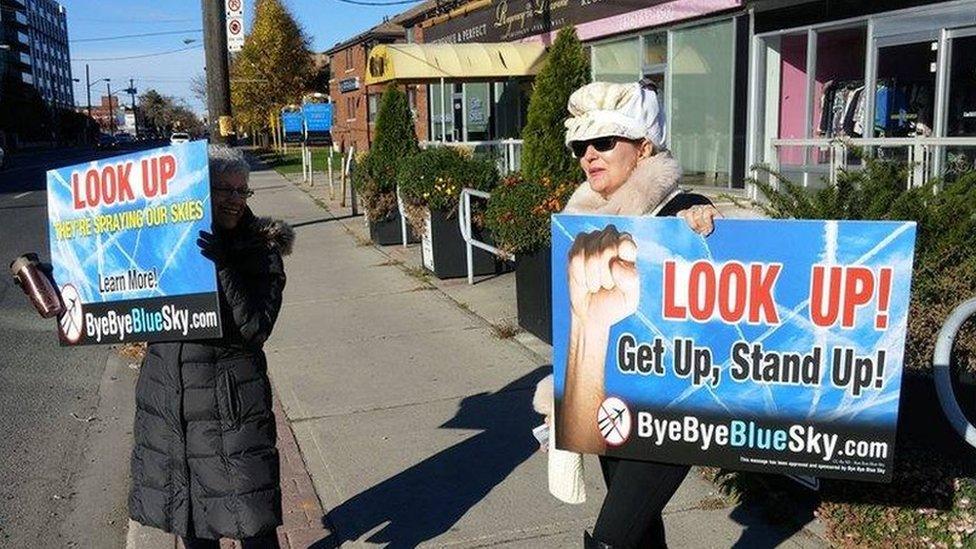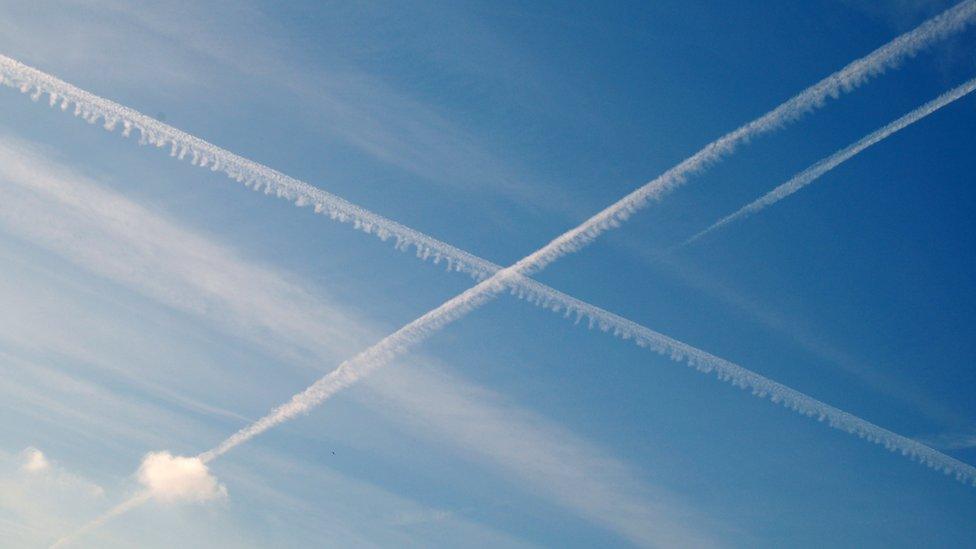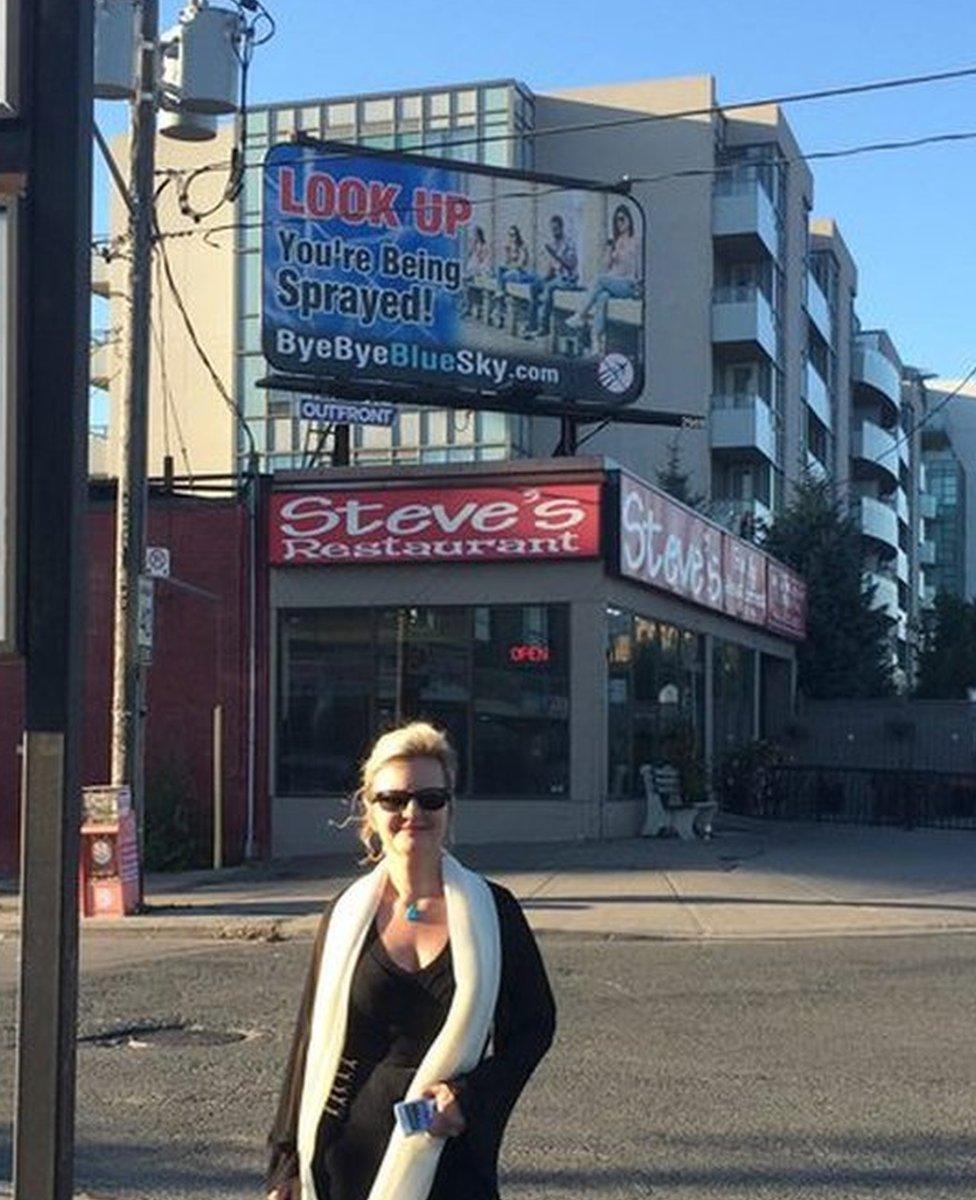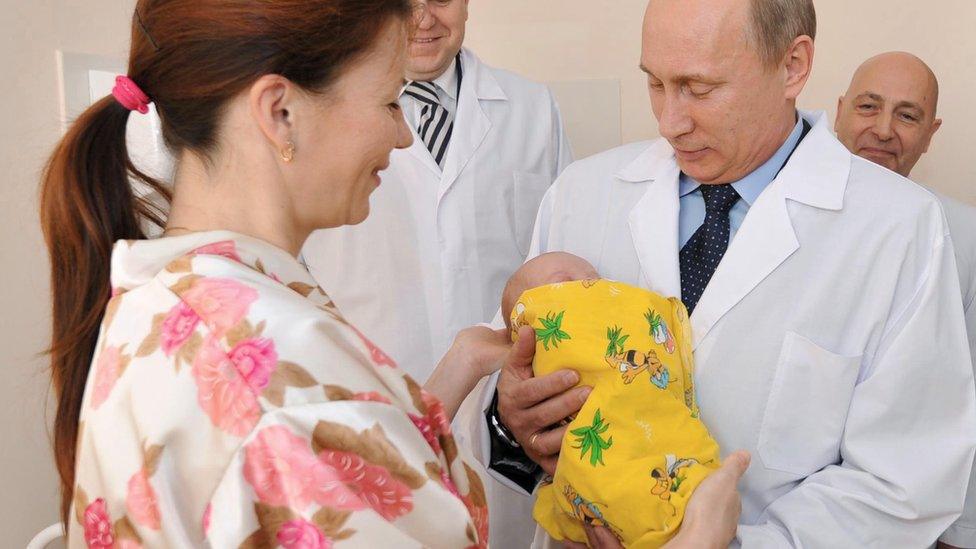'Chemtrail' conspiracy theorists: The people who think governments control the weather
- Published

Suzanne Maher, right, and another activist promote Bye Bye Blue Sky
Those white lines in the sky trailing behind jet planes are puffy plumes of water vapour. But online, some have twisted them into evidence of a secret plot to control weather or poison the environment. Why are wild theories about contrails and other phenomena so persistent on social media?
Suzanne Maher doesn't like the term "conspiracy theory".
When I use it - on a phone call to arrange an interview - she tells me that it was invented by the CIA to discredit those who question the government.
But as the founder of Bye Bye Blue Sky - a group established to raise awareness of so-called "chemtrails" and what she claims is a massive, secret government conspiracy to control the weather - it's one the Canadian is used to hearing.
"I ask that we move beyond the notion that this is a conspiracy theory," she says. "Twenty to thirty years ago we never saw these trails. We had a beautiful blue sky."
More on online conspiracy theories
Suzanne is among a significant number of people using social media to spread this message.
"Chemtrail" conspiracy theorists vary in their claims. But some of the most popular include the belief that governments control the weather on a massive scale, that scientists carrying out legitimate research about how to counteract climate change through a process called geo-engineering are secretly poisoning us, or even that secret powerful groups are spraying us with chemicals to make us pliant and easy to control.
The trails she's talking about are those you'll have seen yourself - plumes of white that form behind aircraft. They are simply water vapour released from aircraft engines that condenses into ice crystals if the atmospheric conditions are right. Suzanne Maher isn't correct when she says they're a new phenomenon: you can see condensation trails left behind aircraft in images from the Battle of Britain, external during the Second World War.
But what most people call "contrails" Suzanne and other conspiracy theorists call "chemtrails" - and in them they see evidence of a clandestine globalist conspiracy involving a pick-and-mix selection of the UN, the military, national governments, the Rothschilds, climate scientists, pilots and big business.

Some people claim trails left by aircraft in the sky are evidence of a government conspiracy
Her beliefs don't exactly come from nowhere.
Weather modification - or at least attempting it - has a long history. The Leningrad Institute of Rainmaking was established in the Soviet Union in 1932. Chinese authorities used cloud seeding to ensure the opening ceremony of the 2008 Olympics wasn't washed out.
Geo-engineering - deliberate intervention in the Earth's natural systems to counteract climate change - is a newer field of research. While scientists have talked about it, there's been very little being physically done - most of the research in the field relies on computer modelling.
Professor David Keith of Harvard University, is among the most prominent scientists calling for further research. He told the New York Times, external he knows of only two instances where one of the most controversial proposals has been tested in the field. It's called solar geo-engineering and involves atmospheric aerosol injection of tiny reflective particles to reduce the amount of sunlight reaching the earth and thus cool the planet.
Similarly, successful weather modification efforts have been localised - and certainly not on the grand scale some conspiracy theorists claim.
Nonetheless, "chemtrail" and geo-engineering conspiracy theorists flood social media with speculation, questions and images of contrail cross-hatched skies. One international survey, external suggested almost 17% of respondents thought chemtrail conspiracy theories true or partly true.
Suzanne says she first became aware of the subject six years ago.
"I was actually on a website. It was a very young girl, she wasn't even ten years old. She talked about the spraying going on in our skies and the fact she was so sad because she didn't want to go outside and the skies were no longer blue and we were being sprayed. Why would such a young child be sharing this information if it wasn't truthful?
"Her words disturbed me and intrigued me so I began looking into this topic and doing extensive research. This awakening truly changed my life," she says.

Suzanne Maher in front of a Bye Bye Blue Sky billboard in Toronto
That research led Suzanne to create Bye Bye Blue Sky. She runs a closed group on Facebook, where around 5,000 fellow believers can discuss the theory, as well as raising money to buy billboard advertising. She closely vets the group's members.
"We don't debate that it's happening in this group," she says. "We all realise that it is happening."
'Information bubbles'
Closed groups of like-minded people - the type common on social media and the internet - are one of the big reasons why conspiracy theories solidify online. Professor Karen Douglas, from the University of Kent, researches the psychology of conspiracy theories.
"People tend to share information but also consume information that's consistent with what they already believe," she says.
"People end up living in these information bubbles, or echo chambers, where they share ideas with other people who believe what they believe. And they read information which confirms what they believe.
"Information doesn't necessarily spread indiscriminately the way people think it does on the internet and social media. People tend to share it with people who kind of think the same way as they do about these issues in the first place," she says.
'I taste and smell it'
Russ Tanner runs what he claims is the largest "chemtrails" group on Facebook - Chemtrails Global Skywatch - which has more than 114,000 members. He calls so-called chemtrails "the largest crime against humanity in history".
In a post typical of the paranoia among conspiracy theorists, one of the memes he's posted in his group asks if chemtrails are "the modern implementation of eugenics and forced depopulation".
At his request, I contact Russ at 8am in the UK - 3am in Maine, where he lives.
"The main reason I wanted to do the interview at night is in our area we have an enormous amount of aerosol injection that takes place through the evening," he tells me.
"I can't sleep when the air is that concentrated with this fallout. It causes me physical symptoms. I taste and smell it. It burns my sinuses, causes inflammation, rises in blood pressure, stomach issues and headaches."

Suzanne Maher says her group has bought more than 20 billboards across North America
Both Russ and Suzanne claim to have conducted their own scientific tests. Suzanne says she even tested her dog.
"I had my soil tested. I had my hair tested," she says. "I was toxic in aluminium, barium, strontium, arsenic, manganese. And I live very healthily." She says her dog has been poisoned by a radioactive metal.
Russ claims he found six times the safe levels of aluminium in his rainwater, and both say the tests are solid proof of atmospheric spraying.
It's not known what's behind those test results - and they couldn't be independently verified. Scientists, of course, disagree that there is any large-scale plot by governments to spread chemicals around the globe.
A 2016 study by the Carnegie Institute for Science and the University of California Irvine, external surveyed 77 leading atmospheric scientists and geochemists. All but one, 98.7%, reported no evidence of a secret large-scale atmospheric spraying programme. The one scientist who dissented recorded unusually high levels of atmospheric barium in a remote area with low levels of barium in the soil. But to get from that one result to the idea that we're being secretly sprayed with chemicals requires a monumental leap of faith.
"Our goal is not to sway those already convinced that there is a secret, large-scale spraying programme - who often reject counter evidence as further proof of their theories - but rather to establish a source of objective science that can inform public discourse," the study's authors wrote.
The conspiracy theorists won't be swayed.
"We have a long history in all countries of scientists believing things that we later realise are false," Russ contends. "It takes a very rare and brave person who steps out and goes against the flow.
"Whether or not people listen, that's up to them. But as for me - this is happening."
Blog by Chris Bell
More from Trending: What's up with Russia's declining birth rate?

The news of Russia's birth rate dropping by 10.6 per cent in 2017 to reach its lowest level in 10 years, despite government measures to boost fertility rate has prompted debate online. READ MORE
You can follow BBC Trending on Twitter @BBCtrending, external, and find us on Facebook, external. All our stories are at bbc.com/trending.